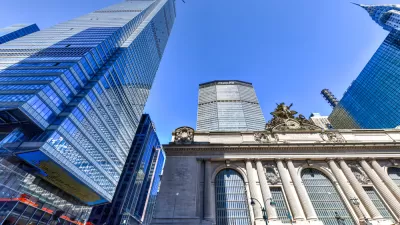In exchange for the approval to build One Vanderbilt, a 63-story office tower adjacent to Grand Central Terminal, the developer will give the MTA $220 million for upgrades to entrances of the Metro-North Railroad and the terminal's subway entrances.
The City Council gave its approval for the plan on May 27, overcoming what was considered the biggest obstacle to the tower and the transit improvements.
"Plans for the skyscraper have been at the center of long-running negotiations to improve the bustling subway station at Grand Central [second busiest after Times Square], particularly on the overcrowded 4, 5 and 6 trains on the Lexington Avenue subway line," writes Emma G. Fitzsimmons for The New York Times. "Mayor Bill de Blasio has supported the rezoning plan."
As part of the deal, the developer, SL Green Realty, will build new subway entrances as well as a pedestrian plaza at street level, a public hall in the building’s lobby and other upgrades.
The approach has been viewed by some proponents as a model for how the Metropolitan Transportation Authority can pay for some projects as it grapples with a $14 billion shortfall in the agency’s $32 billion proposed capital plan.
The location at the corner of 42nd Street and Vanderbilt Avenue is adjacent to the landmark terminal. The tower is opposed by Andrew S. Penson, "(t)he investor who owns Grand Central, " writes Fitzsimmons. "He has argued that the agreement would be a 'massive giveaway' to a big real estate company."
The 1,501-foot-tall, 1.6 million-square-foot skyscraper building will be the city's third tallest, dwarfing the nearby 1,046 feet-tall, 71-story Chrysler Building. "The tower and the infrastructure upgrades are expected to be finished by 2021, the company said," notes Fitzsimmons.
The Council's approval is a reversal from an earlier upzoning plan, backed by Mayor Michael R. Bloomberg for the area known as East Midtown.
"SL Green will also pay for direct connections beneath the tower to the subway, the Metro-North Railroad and eventually the Long Island Rail Road, which will stop in Grand Central after the authority’s East Side Access Project is complete," adds Fitzsimmons.
Transit advocates have also applauded the Grand Central deal, saying it served as a test case for incentive plans in which developers pay for transit improvements in exchange for permission to build.
Similar arrangements have been done at Boston's Back Bay Station and at Atlanta's MARTA stations, though they were for air rights and perhaps not on the same scale as the Metropolitan Transportation Authority (MTA) has worked out for the 63-story office tower known as One Vanderbilt.
Hat tip to Jennifer Scholtes, transportation reporter for POLITICO Morning Transportation.
FULL STORY: Plan to Build Tower at Grand Central in Exchange for Transit Upgrades Is Approved

Study: Maui’s Plan to Convert Vacation Rentals to Long-Term Housing Could Cause Nearly $1 Billion Economic Loss
The plan would reduce visitor accommodation by 25,% resulting in 1,900 jobs lost.

Alabama: Trump Terminates Settlements for Black Communities Harmed By Raw Sewage
Trump deemed the landmark civil rights agreement “illegal DEI and environmental justice policy.”

Why Should We Subsidize Public Transportation?
Many public transit agencies face financial stress due to rising costs, declining fare revenue, and declining subsidies. Transit advocates must provide a strong business case for increasing public transit funding.

Paris Bike Boom Leads to Steep Drop in Air Pollution
The French city’s air quality has improved dramatically in the past 20 years, coinciding with a growth in cycling.

Why Housing Costs More to Build in California Than in Texas
Hard costs like labor and materials combined with ‘soft’ costs such as permitting make building in the San Francisco Bay Area almost three times as costly as in Texas cities.

San Diego County Sees a Rise in Urban Coyotes
San Diego County experiences a rise in urban coyotes, as sightings become prevalent throughout its urban neighbourhoods and surrounding areas.
Urban Design for Planners 1: Software Tools
This six-course series explores essential urban design concepts using open source software and equips planners with the tools they need to participate fully in the urban design process.
Planning for Universal Design
Learn the tools for implementing Universal Design in planning regulations.
Smith Gee Studio
Alamo Area Metropolitan Planning Organization
City of Santa Clarita
Institute for Housing and Urban Development Studies (IHS)
City of Grandview
Harvard GSD Executive Education
Toledo-Lucas County Plan Commissions
Salt Lake City
NYU Wagner Graduate School of Public Service



























